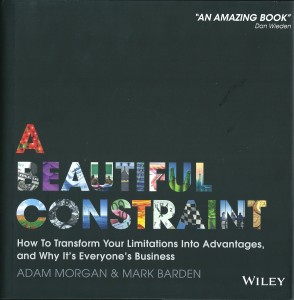The one sentence summary
Constraints can lead to greater originality and ingenuity.
Can’t be bothered to read it? Listen to the 5-minute summary.
WHAT THE BOOK SAYS
- This is all about turning apparent constraints into sources of possibility and advantage. The overall message is that, contrary to popular belief, constraints can lead to more originality and ingenuity.
- It all starts with getting out of the victim stage (“We’re really inhibited here.”), through the neutralising stage (“Our ambition is too important to allow this constraint to inhibit it.”), to arrive at the transformer stage (“Let’s use this to stimulate better thinking.”)
- The main recommendations are:
Break path dependence*
Most companies have a bundle of premises, processes, assumptions and ways of thinking that define “the way we do things round here.” This locked-in path is predictable and often doesn’t work.
Ask propelling questions**
These crucially bind a bold ambition to a significant constraint. They must be specific, legitimate and authoritative.
Can-If
This comes mainly from Colin Kelly, Director of R&D at Warburton’s. Instead of listening to naysayers saying: “We can’t because”, he insists on problem solving language re-phrased as “We can if…” This approach keeps optimism in the process, and forces people to take responsibility for finding answers, rather than identifying barriers.
Create abundance
We nearly always have more resources available than we think. More imaginative thinking is needed to get round resource problems.
Activate emotions
Scientists have found a strong link between success in working around obstacles and having an emotional connection to the goal. Team leaders can identify the tension in these and develop a narrative to energise the team.
WHAT’S GOOD ABOUT IT
- The Fertile Zero explains how we can learn from people who succeeded with next to nothing.
- The Four Seasons Hotel has renamed its laundry department from “The Back end” (derogatory) to “Heart of House” (with a sense of pride).
WHAT YOU HAVE TO WATCH
- There is a lot of American material in the book, which may resonate less well with UK readers.
- The same brands are referred to again and again. It might have been more accessible if each case history were outlined once, and then cross-referred to the method.
*Diligent students of Morgan’s work will notice that this notion is very similar to Break with your immediate past, in Eating The Big Fish.
**And this notion is very similar to the outlooking, pushing and denting suggestions in The Pirate Inside.
